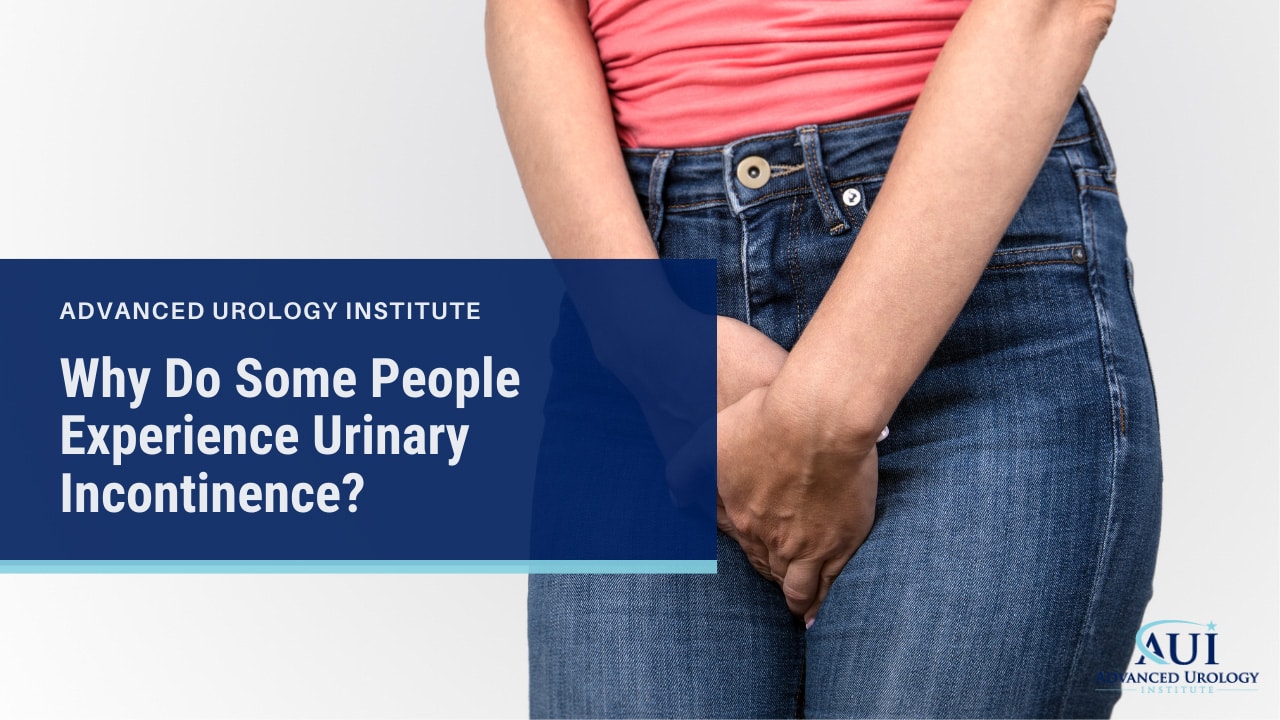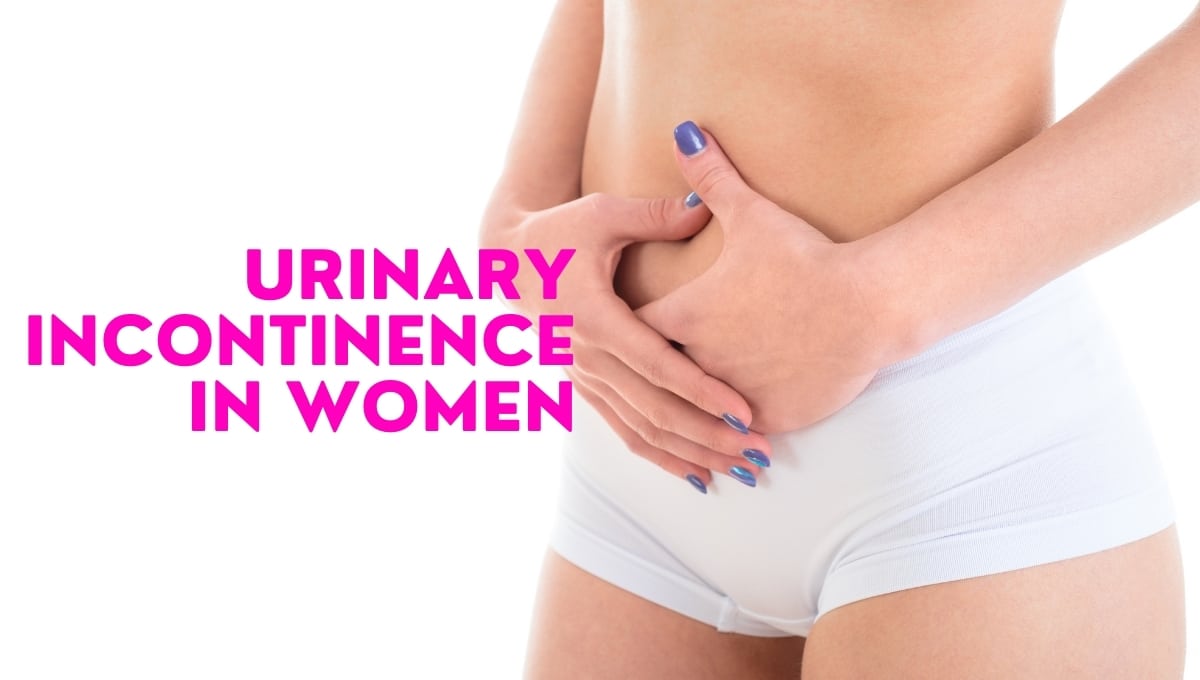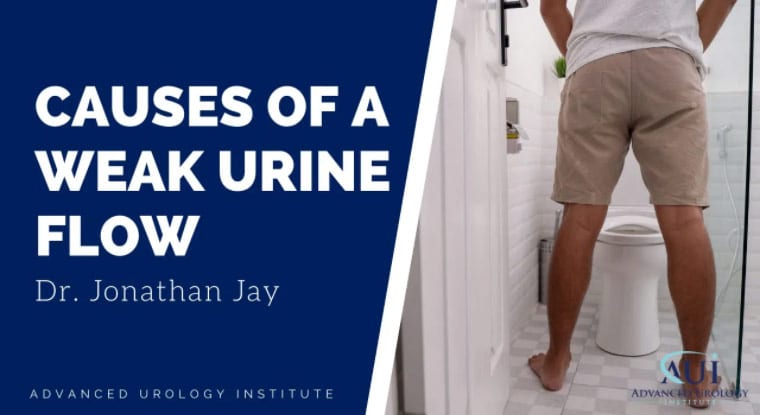Drs. Jay and Bassel, board-certified urologists in Naples and Palm Harbor, FL, respectively, talks about addressing common female urology problems.
Continue readingWhy Do Some People Experience Urinary Incontinence?
People experience urinary incontinence because of several factors including age, gender, pregnancy, and medications that you take.
Continue readingWhat Are the Biggest Risk Factors for UTI?
Uncover the Biggest Risk Factors for UTI. Learn more about Factors that Can Increase Vulnerability to Urinary Tract Infection.
Continue readingMost Common Urological Problem In Women – Dr. Ketan Kapadia
Most Common Urological Problem in Women Revealed by Dr. Ketan Kapadia! Discover More Insights at Advanced Urology Institute.
Continue readingWhat is Urinary Incontinence in Women and how can Dr. Amar Raval help?
Dr. Samuel Lawindy Talks About How to Treat Urge Incontinence in Women
What are the Conditions We Treat at Advanced Urology Institute?
Common Female Urology Problems
My name is Yaser Bassel, I’m a board certified urologist with Advanced Urology Institute. We see a lot of women, in particular for issues with incontinence or involuntary loss of urine. And there are multiple reasons for having that
Continue readingUrinary Incontinence in Women
The loss of bladder control known as Urinary Incontinence is a normal problem that is more common in women than men. The effects of urinary incontinence range from barely noticeable to severe. As Dr. Amar Raval from the Advance Urology Institute says, “It is a big issue for women out in public.” Incontinence can cause difficult and embarrassing situations.
There are many causes of urinary incontinence. To understand these causes, it is important to remember that urinary incontinence is a symptom, not a disease. Lifestyle choices that can exacerbate the problem include consuming alcohol, caffeine, spicy foods and certain medications. For women, life events that affect women’s bodies in a way that can cause incontinence include pregnancy, childbirth, menopause and aging. Other causes can be found in weight, family history and health.
 The different types of urinary incontinence can exhibit a variety of symptoms. Stress incontinence is characterized by small leaks of urine due to pressure on the bladder while laughing, coughing, sneezing or exerting oneself. The small leaks of overflow incontinence happen when the bladder has not fully emptied during urination. Urge incontinence is the sudden and intense urge to urinate, sometimes resulting in an involuntary loss of urine. Having to urinate frequently through the night is another symptom experienced by women with urge incontinence. It is also common for women to be affected by more than one of these types of incontinence.
The different types of urinary incontinence can exhibit a variety of symptoms. Stress incontinence is characterized by small leaks of urine due to pressure on the bladder while laughing, coughing, sneezing or exerting oneself. The small leaks of overflow incontinence happen when the bladder has not fully emptied during urination. Urge incontinence is the sudden and intense urge to urinate, sometimes resulting in an involuntary loss of urine. Having to urinate frequently through the night is another symptom experienced by women with urge incontinence. It is also common for women to be affected by more than one of these types of incontinence.
Fortunately, a wide range of treatment options is available. Women can work with their urologist to find the best treatment option for their individual situation. In some cases, treatment can be as easy as making slight lifestyle changes or taking an oral medication. Botox and acupuncture can help relieve stress incontinence. For more advanced cases, urethral slings can ease symptoms by lifting the urethra into a normal position, and robotic surgeries can lift the bladder in cases of incontinence caused by a prolapse.
The loss of bladder control can be a lifestyle limiting problem for women when it affects their ability to leave the house and maintain normal activities. The urologists at the Advance Urology Institute work closely with each patient to ensure they can live with freedom and confidence, and without the worries of incontinence. For more information, visit the Advanced Urology Institute website.
Urologists Also Treat Women
The Two Most Common Female Urology Problems
Although it can feel embarrassing to discuss them with your doctor, problems with your kidneys, bladder and other parts of the urinary system are very common and are usually highly treatable. For women, two of the most common problems are urinary tract infections (UTIs) and urinary incontinence.
Urinary Tract Infection
 A urinary tract infection is an infection of a part of the urinary system which includes the bladder, kidneys, ureters and urethra. A UTI can occur when bacteria enters the urinary system, usually via the urethra. Symptoms of a UTI include a strong, constant need to urinate, a burning sensation during urination, and urine that is cloudy or pink or red-tinged and has a strong smell. There also may be pain around the pelvis. Although UTIs are usually not serious, if the infection spreads from the bladder into the kidneys, complications can occur. If you are diagnosed with a UTI, your doctor most likely will prescribe antibiotics to help clear up the infection.
A urinary tract infection is an infection of a part of the urinary system which includes the bladder, kidneys, ureters and urethra. A UTI can occur when bacteria enters the urinary system, usually via the urethra. Symptoms of a UTI include a strong, constant need to urinate, a burning sensation during urination, and urine that is cloudy or pink or red-tinged and has a strong smell. There also may be pain around the pelvis. Although UTIs are usually not serious, if the infection spreads from the bladder into the kidneys, complications can occur. If you are diagnosed with a UTI, your doctor most likely will prescribe antibiotics to help clear up the infection.
UTIS are more common in women than men because women have shorter urethras. There are easy steps you can take to prevent getting a UTI. Drinking plenty of liquids, wiping from front to back after using the restroom, and urinating soon after sexual intercourse are all important preventative measures you can take to reduce your risk of developing a UTI.
Incontinence
Urinary incontinence, or the involuntary release of urine, is also a common problem for women, especially those who have given birth or have gone through menopause. These life events weaken the pelvic floor, making muscle control around the bladder more difficult. Incontinence also can be caused by weak or overactive bladder muscles or nerve damage.
Incontinence can vary in severity. For some women, this means only a few drops of urine being released when they cough or laugh. Others may experience a sudden urge to urinate and lose control of their bladders before they have time to get to a restroom. This can cause feelings of embarrassment and keep women from participating in activities they enjoy. Thankfully, urinary incontinence is very treatable. If it is becoming a major nuisance in your life, talk to your doctor about specific treatment steps to permanently help deal with the issue rather than addressing the symptoms.
Although problems with the urinary system can feel embarrassing, it is important to remember that you are not alone and that these issues are treatable. The physicians at Advanced Urology Institute are here to help with any urological issues you may be facing. For more information, visit the Advanced Urology Institute website.
How Do You Treat Common Urology Problems?
There are numerous conditions that affect the urinary system in both men and women. Ordinarily, diseases of the urinary system affect one or more parts of the urinary system, including the kidneys, bladder, urethra, ureters, and in men, the prostate gland.Common urology problems include urinary tract infections, incontinence or urine leakage, pelvic organ prolapse in women, overactive or underactive bladder, enlarged prostate in men and kidney or bladder stones. Most urological conditions can be treated and the patient can return to full health.
Treatment of Common Urology problems
The treatment of a patient will depend on how far the illness has progressed and how severe the symptoms are. The most common treatment methods are:
1. Behavioral modifications and Physical Therapy
Once a specific condition is diagnosed, the first course of treatment focuses on:
a. Changing any of the patient’s behavioral practices that may contribute to the disease; and
b. Introducing practices that strengthen the affected organ or the body in general.
For example, when patients are diagnosed with incontinence, they may be advised to cut down on the intake of fluids such as water and coffee. Similarly, patients with pelvic organ prolapse may be advised to undertake pelvic exercises to strengthen the muscles of the pelvic floor.
2. Medication
Medication can be prescribed for urological conditions in the same way that they are prescribed for other illnesses. Medication works for moderate to severe illnesses that cannot be managed through behavioral modifications alone. Some medications are taken orally while others may be injected. The most common categories of drugs include:
a. Antibiotics. Antibiotics treat simple cases of urinary tract infections successfully.
b. Anticholinergics. These treat an overactive bladder.
c. Alpha-blockers. These are used to treat prostate enlargement in men.
3. Surgical Procedures
The severity of a problem may require that a patient undergo surgery. Most urological surgeries are minimally invasive. Urologists use technological tools that make the procedure less painful and less traumatic, with the result that a patient recovers very quickly. There are a variety of minimally invasive procedures for treating pelvic organ prolapse, incontinence and an enlarged prostate in men.
The appropriate course of treatment can only be determined after tests are conducted and a diagnosis is made. The available forms of treatment may be used. Our specialists at Advanced Urology Institute can help you find the right tests and work with you on a plan of treatment that is most beneficial to you. They can answer any questions or concerns and help you reach your own decisions on your care. For more information, visit the Advanced Urology Institute website.
Causes of a Weak Urine Flow
The inability to start or maintain urine flow, causing dribbling or weak urine flow, is called urinary hesitancy. It can occur at any age for all genders, but it is by far most common among aging men. Urinary hesitancy develops gradually but if left untreated, it can lead to a complete inability to pass urine, also known as urine retention. Due to its prevalence among older men, weak urine flow has always been associated with an enlarged prostate gland, a condition very common in older men. This, however, is not the only cause of a weak urine flow.
Causes of a weak Urine Flow
1. Benign Prostate Hyperplasia (BPH)
Benign prostate hyperplasia is the medical term for an enlarged prostate. As a man ages, the prostate grows to a size larger than what is normal. The prostate’s location around the tip of the urethra means that the enlarged prostate presses on the urethra and blocks the passage of urine. This whole or partial obstruction slows down the flow of urine. BPH is the main cause of a weak urine flow in men over the age of 45.
2. Underactive Bladder (UAB)
 An underactive bladder is a medical condition characterized by weak urine flow and an inability to empty the bladder completely. The condition is best understood as the opposite of the overactive bladder (OAB) which has received wider attention and is known to cause urinary incontinence, the urgent and frequent urges to urinate. Patients suffering from an underactive bladder have a diminished sense of when their bladder is full and are not able to contract the bladder fully. The condition can occur when there is damage to the bladder peripheral pathways or to the lumbosacral spinal cord. It is also common in patients suffering from diabetes mellitus, neurological diseases, Parkinson’s disease and pelvic fractures.
An underactive bladder is a medical condition characterized by weak urine flow and an inability to empty the bladder completely. The condition is best understood as the opposite of the overactive bladder (OAB) which has received wider attention and is known to cause urinary incontinence, the urgent and frequent urges to urinate. Patients suffering from an underactive bladder have a diminished sense of when their bladder is full and are not able to contract the bladder fully. The condition can occur when there is damage to the bladder peripheral pathways or to the lumbosacral spinal cord. It is also common in patients suffering from diabetes mellitus, neurological diseases, Parkinson’s disease and pelvic fractures.
3. Bladder Outlet Obstruction (BOO)
As the name suggests, this is a condition that occurs when there is a blockage at the neck or the base of the bladder. The blockage completely prevents or reduces urine flow from the bladder. It occurs in both women and men, but is more common in older men. It can be caused by bladder stones, scar tissue in the urethra, bladder cancer or an enlarged prostate.
It is clear that weak urine flow has a variety of causes. It is very important to see a urologist to determine the exact cause of a weak flow. An appropriate plan of treatment can be set up once it has been determined what is creating the problem. It is recommended that you consider seeking out trained, experienced and board approved urologists if you are having problems with weak urine flow.
At AUI, we offer patient-friendly and multidisciplinary urology services for a wide range of problems, including weak urine flow. For more information, visit the “Advanced Urology Institute” site.
For more information, visit the “Advanced Urology Institute” website.













 (UTIs) are another issue that brings many women, especially older women, to their urologist’s office. UTIs are another urinary issue that can affect both men and women, but they are far more common in women than men. About half of all women will have a UTI in their lifetimes, while only 1 in 10 men will. UTIs are infections that happen in the bladder or urethra. Symptoms include burning while urinating, frequent urges to urinate, and pain in the lower back and abdomen. Urologists can prescribe antibiotics to treat the infection.
(UTIs) are another issue that brings many women, especially older women, to their urologist’s office. UTIs are another urinary issue that can affect both men and women, but they are far more common in women than men. About half of all women will have a UTI in their lifetimes, while only 1 in 10 men will. UTIs are infections that happen in the bladder or urethra. Symptoms include burning while urinating, frequent urges to urinate, and pain in the lower back and abdomen. Urologists can prescribe antibiotics to treat the infection.

